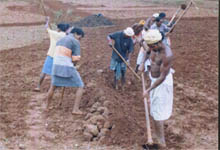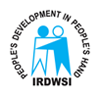SUSTAINABLE AGRICULTURE
To co-ordinate sustainable aquaculture in 10 villages in 1998, staff visited and followed up 339 families educated them to carry out a sustainable culture programme. we received much help from the ouat, with assistance of educated scientists.
Indigenous Seed and Soil Sample Collection
8 Varieties of seeds (Paddy, Ragi, Suan, Kandul, Beans Bulta, beans and Chilli) were collected from 10 villages in 1998 and documented. The collected seeds were demonstrated in other villages. In 1999 the staff collected sample soil from 32 families for testing and was sent to the OUAT lab. As a result, the farmers could cultivate suitable crops. Indigenous seeds were collected by the staff in 1999 and are documented and multiplied in the demonstration field.
Village Visits and Farmers Meeting
Farmers meeting were organized at field office in 1998. from 6 villages 6 farms attended in the meeting and were trained on agriculture, vegetable cultivation, crops position check-up, bed preparation and digging compost pits. The training was followed up with field practical. During 1999 the staff visited 14 demonstration villages and one model village regularly and conducted farmers meetings in the villages and the center where they discussed crop types. position and problems the senior scientist from Ouat and agriculture officer at the block demonstrated croup and sis ease pattern in various vegetables. They also demonstrated land preparation, use of organic manure. Use of local and indigenous seeds, irrigation source and the advantage of double cropping..
Production of Organic Manure and Compost Pits
During 1999 the staff educated to farmers in 10 villages on compost pits, how to make their compost with cow dung, agriculture waste and forest littler. One compost pit was dug in each 9 villages. and in the model village, Porajpungar, 8 new pits were dug.
Vermiculture
The project initiated vermi mother culture on sample basis at IRDWSI office. The scientist trained the agriculture team to prepare the be and develop vermi culture. A demonstration was conducted at the center. A study was undertaken to multiply the culture later for application at paddy and vegetable field. To develop the culture, 3 months is needed and the vermi compost was ready in June 1999 and farmers can now use in the fields.
Identification of Pest and Treatment
During 1999, the staff recorded the pests that effected the crops and vegetable gardens. The scientist educated the farmers on preventive measures to take steps to avoid the problems of pest to the crops. The scientist explained the application of name oil.
Intercrop
all the 10 villages the staff visited were encouraged and motivated to cultivate inter crop such as beans with cabbage, maize with chili, ginger with beans etc. Due to inter crop the yield will be increased and the farmers will et more income from their limited land.
Waste land Development
 Land development programmed was imitated in 10 villages for 50 families on 13.40 acres. The marginal farms waster land was identified, guide Nance and assistance was given for stone packing, counter binding, leveling, foam plantation and we also introduced 5 % in each plots to control moisture.
Land development programmed was imitated in 10 villages for 50 families on 13.40 acres. The marginal farms waster land was identified, guide Nance and assistance was given for stone packing, counter binding, leveling, foam plantation and we also introduced 5 % in each plots to control moisture.

